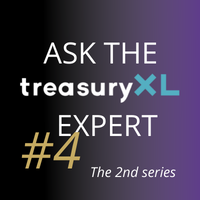Ask the treasuryXL expert #4 What is RPA, and what are common use cases of RPA in Treasury?
06-09-2022 | treasuryXL | Philip Costa Hibberd| LinkedIn |
treasuryXL is the community platform for everyone with a treasury question or answer! treasuryXL expert Philip Costa Hibberd is often asked what RPA exactly entails and what some typical treasury use cases for RPA are. In today’s article Ask the treasuryXL Expert, Philip tells us all about RPA software and when it is happening in treasury.

Question: “What is RPA, and what are common use cases of RPA in Treasury?”
Answer provided by Philip
What is RPA (Robotic Process Automation)?
RPA stands for Robotic Process Automation and is a software that performs rules-based work, interacting with systems, websites and applications in the same way a human would. Think of Excel Macros on steroids. With RPA, you can program robots to do the repetitive tasks that nobody wants to do. Robots work 24/7, are fast, make no mistakes, and are very cost effective
Sounds good… but does this mean that we”ll soon be out of a job? No. Quite the opposite.
Robots are great at performing repetitive, standardised and time-consuming tasks, but are not great at dealing independently with the uncertain and complex world in which treasurers operate. This is why bots and treasury professionals are such a great combination. Bots give us superpowers: they give us back the time we need to focus on the valuable activities that make the job interesting and at the same time they allow us to keep direct control over the repetitive (but often critical) processes we need to do (without actually having to do it ourselves).
What are common use cases of RPA in treasury?
- Reporting: collecting information from different sources, calculating measures and KPIs, drafting the reports, distributing the reports (after getting confirmation that everything is ok).
- Master data management: support with the creation, updating, deletion and cleansing of master data in different sources and systems. Synchronizing data across systems.
- Cash Position: collecting bank statements/account balance information from different systems, consolidating information, saving and/or distributing the cash position information to the appropriate people and systems.
- Payment processing: collecting and consolidating payment requests, handling predefined exceptions and validations, inputting/uploading payment batches before cut-off times, providing reports and feedback on each action.
- Cash Flow Forecasting: collecting cash flow data from different systems and sources, sending automated reminders, consolidating the information, applying validations and checks, notifying exceptions, distributing the information.
- Month end activities: sending notifications/reminders on deadlines and expected activities, collecting and distributing FX rates, consolidating information, performing automatic checks, limit checks, compiling and distributing month end reports to accounting / FP&A / etc.
- User and access management: checking user roles and statuses in different systems, notification of accesses about to expire, creating accounts for joiners and disabling accounts of leavers.
- Mark-to-market valuations: collecting deal confirmations from different sources, extracting information from different mediums (excel, PDF, emails), running the models, preparing and distributing the reports.
- Covenant management: collecting the information from different sources, calculating the ratios, warning of (imminent) breaches, warning of risky trends, distributing reports.
- Bank fee monitoring: gathering bank statements / CAMT.086 / Bank Services Billing (BSB) from different systems, processing the information, generating and distributing reports, automatic disputing of fees based on predefined rules.
- Chargeback / Credit card disputes: collecting pre and post approval information, filing the disputes, notifying users of responses and exceptions/follow up needed.
- Automated testing regression testing of ERP/TMS/system updates, bank connectivity testing, end to end process testing, generating testing reports and evidence.
- (Basic) Trading: computing of exposures, inputting vanilla deals in trading platform (if within predefined limits – otherwise notify traders), deal execution according to trading policy, handling of post trade activities.
Thank you for reading,
Phillip Costa Hibberd
Do you also have a question for one of the treasuryXL experts? Feel free to leave your question on our treasuryXL Panel. The panel members are willing to answer your question, free of charge, with no commitment.






